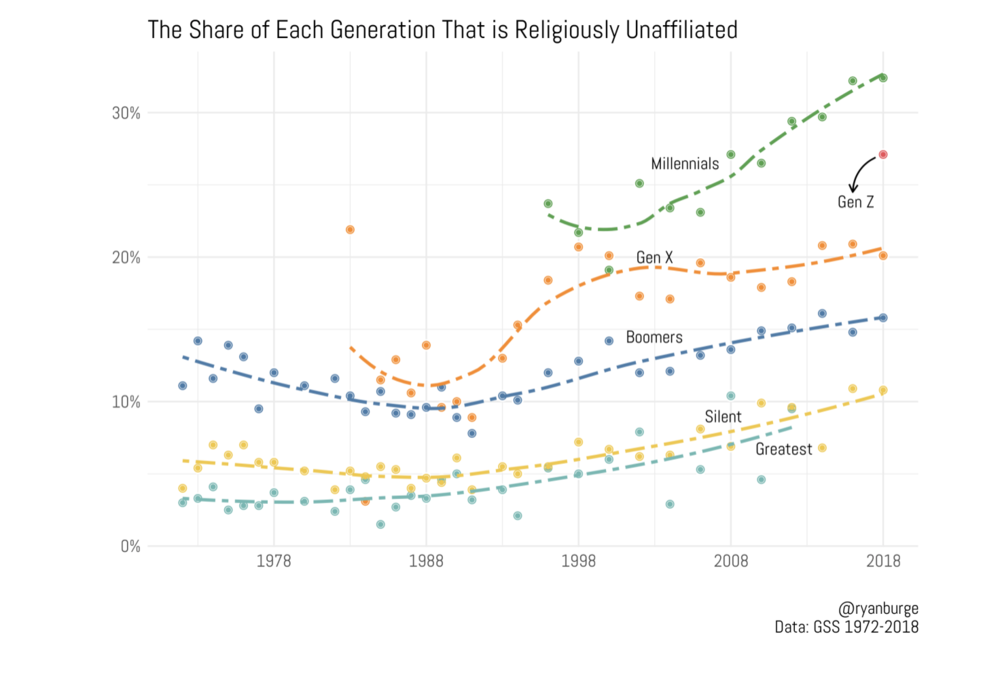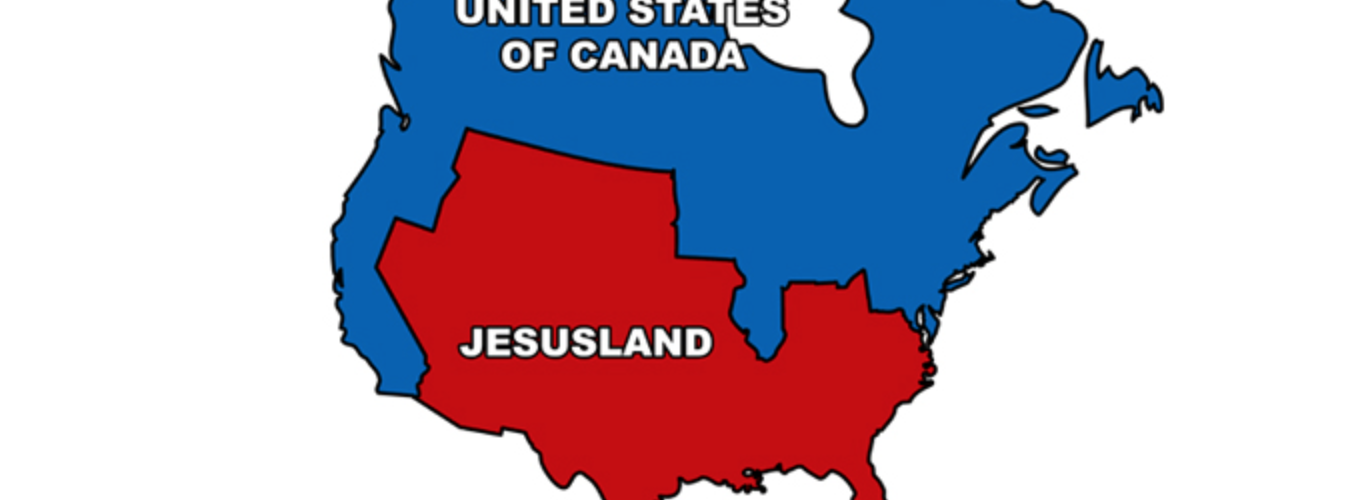
Here is a headline that I was not expecting from Ryan Burge and his colleagues at the Religion in Public weblog: “The Decline of Religion May Be Slowing.”
Argue with this crew all that you want. But what we have here is another snapshot of poll numbers that demonstrates why Religion in Public is a website that religion-beat professionals and their editors really need to have bookmarked. When in doubt, just follow GetReligion contributor Ryan Burge on Twitter.
In this case, Yonat Shimron of Religion News Service spotted this story pronto. We will come back to that report in a minute. But first, here is the top of the crucial Religion in Public post, written by Paul A. Djupe and Burge:
In a companion piece published … on Religion in Public, Melissa Deckman of Washington College finds that the probability of being a religious none in Gen Z (born after 1995) is the same as for Millenials (born between 1981-1994). This bombshell finding sent us running for other datasets. Like all good scientists, we trust, but verify. …
It is conventional wisdom at this point that the incidence of religious nones is on a steady rise after 1994. Driven by a mix of politics, scandal, and weak parental religious socialization, non-affiliates have risen from about 5 percent to 30 percent. That trend appears to be accelerating by generation, so the rate of being a religious none is much greater among Millennials than it is among Greatest, Silent, and Baby Boomer generations as the figure below shows using the General Social Survey time series. Those older generations are still experiencing some secularization (the rates are rising across time), but not nearly as rapidly as the young. From this evidence, we expected that the rate of being a none among Gen Z might be even higher, leading to a bump above Millennials. The initial, small sample estimate from the General Social Survey, however, suggests that Gen Z is not outpacing Millenials and may have even fallen behind.
The assumption for some media-beat pros, including me, has been that the percentage of actively involved religious believers would remain fairly steady — somewhere around the 20-22% numbers that appear in Gallup Organization work for several decades.
However, it seemed like the “Nones” were going to keep growing by feeding on the vast, mushy, sort-of-religious middle of the American marketplace. Thus, it appeared that the growth potential for a coalition of atheists, agnostics and Nones on the other side of the public square was massive.
This is a massive religion story, of course. But there is no question that it has valid political implications.
With that in mind, let’s flash back — again — to one of my first encounters with this data.
That was in 2008, when University of Akron scholar John Green spoke to a circle of international journalists at the old Washington Journalism Center.
… Green stood at a whiteboard and described the changes that he was seeing in the landscape of American religion. Everything he said on that day showed up years later, in the 2012 Pew Forum study of the religiously unaffiliated.
On the right side of the American religious marketplace, defined in terms of doctrine and practice, is a camp of roughly 20 percent (maybe less) of believers who are seriously trying to practice their chosen faith at the level of daily life, said Green. Then, on the other end of the spectrum, there is a growing camp of people who are atheists, agnostics or vaguely spiritual believers who define their beliefs primarily in terms of the old doctrines that they no longer believe. This is especially true when it comes to issues of salvation and sex. As the old saying goes, on these issues these spiritual-but-not-religious believers reject all absolute truths except the statement that there are no absolute truths.
Green also noted (attention all journalists covering the 2020 primaries) that this coalition on the religious and cultural left was going to become the largest religion-related camp inside the Democratic Party — even larger than church-going African-Americans. This would have tremendous implications for debates about church and state, as well as for abortion and other moral and social issues.
So if there is a chance that the rocketing Nones trend is slowing down, what does that mean to the vague middle of American religious life? This has always been the home of millions and millions of American swing voters.
A key question: Could the North American religion/culture map stay in that famous “Jsusland” configuration?
Meanwhile, here is a crucial chunk of Shimron’s RNS story, addressing the “Why is this happening?” factor, drawing on Deckman’s work and reactions from Djupe and Burge:
The country’s growing racial diversity
The United States will soon be a minority-majority country. Scholars project that might happen between 2041 and 2046, depending on the amount of net immigration into the U.S.
That’s important in terms of religion because minority groups such as African Americans, Hispanics and immigrants from Africa and Asia tend to be more religious than American whites. Deckman, for example, found that 67% of Gen Z Hispanics and 66% of Gen Z African Americans have a religious affiliation, compared with only 58% of Gen Z whites. …
The culture war sorting is mostly over
The past few decades have been marked by a host of divisive social and political issues, including abortion, women’s rights, LGBTQ rights and same-sex marriage. Many religious congregations used to be a lot more diverse on a range of issues. But they have become less so, as both liberals and conservatives have joined up with like-minded congregants or dropped out of religion altogether. …
A changing social desirability bias
This is a related phenomenon. Americans once embraced their religious identities. They are now more willing to admit they don’t have one because it’s no longer socially desirable to declare an affiliation. …
Because this social desirability bias waned considerably over the past decade, it became more acceptable for those marginally religious to report being unaffiliated, which likely contributed to the sharp uptick in nones over such a short time. Now, that group has largely already claimed that status, and those who remain affiliated are committed to their faiths and likely to remain more stable.
Stay tuned.











